A. When it is shown in a pornographic magazine, film or website.
B. Never.
C. When it is emailed to government officials urging action to improve public health.
One could argue about A and B but this blog is [...]]]>
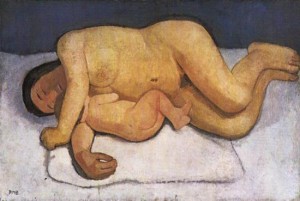
By Paula Modersohn Becker
When is a photo of a woman giving birth considered pornographic? Take your pick:
A. When it is shown in a pornographic magazine, film or website.
B. Never.
C. When it is emailed to government officials urging action to improve public health.
One could argue about A and B but this blog is about C.
Earlier this year, in Zambia, Chansa Kabwela, news editor at the feisty opposition newspaper The Post, was charged with circulating pornography with intent to corrupt public morals. What was her crime? During a nationwide strike by Zambia’s miserably paid doctors, a woman allegedly gave birth without medical assistance in a hospital car park. The baby was in a breech position and later died.
Her family sent Kabwela the photos but she found them too graphic for publication. Instead, she emailed them to the vice-president and other government officials and women’s groups, urging a negotiated end to the strike to avoid more deaths.
President Rupiyah Banda found the photos “morbid and peculiar” and Kabwela, a 29-year-old mother of two, was charged with the porn offence, which carries a five-year jail sentence. The state argued that giving birth is sacred in Zambia and the photos were disrespectful.
If giving birth is so sacred, why was the woman delivering in a car park?
Good sense prevailed and in November a judge acquitted Kabwela.
The Post has long been harassed by government for exposing corruption. This court case is one more instance, using birth, women and tradition as a cover to erode press freedom.
A very famous Christmas birth
This being the season of a famous birth, on the other side of the world, in New Zealand, a mischievous billboard about the immaculate conception has angered Catholics. 
It shows Joseph and Mary in bed. She looks blissful; he looks dejected. The kicker: “Poor Joseph. God is a hard act to follow.”
The twist is that the originator is an Anglican archdeacon who commissioned an ad agency to produce a Christmas poster. The archdeacon argues, somewhat confusedly, that the purpose was to highlight that Christmas is about love, not about Mary’s impregnation by God.
Within hours the billboard was defaced with brown paint. Well, at least this is better than rioting over caricatures of the Prophet or charging an editor with pornography.
Giving birth is charged with cultural meaning: it can be sacred, pornographic, joyful, “eculiar” or offensive. For half a million women, every year, it is deadly.
Yet these deaths do not spark the same outrage as a billboard or photographs.
My wish this Christmas is quite simple: safe delivery for women everywhere, not in a car park and not in a manger, neither holy nor unholy, whether through sex, artificial insemination or immaculate conception. Just safe.
***
Read about why maternal mortality remains so intractable here and about midwives in India.
]]>A Saudi woman journalist escaped punishment last week but her cameraman wasn’t so lucky.
Rozana Al-Yami, 22, was pardoned by Saudi Arabia’s King Abdullah after the court sentenced her to 60 lashes for her work at the talk show Red Line in LBC, a Lebanese satellite TV.
[...]]]>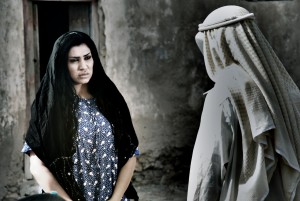
Shall we talk about it?
A Saudi woman journalist escaped punishment last week but her cameraman wasn’t so lucky.
Rozana Al-Yami, 22, was pardoned by Saudi Arabia’s King Abdullah after the court sentenced her to 60 lashes for her work at the talk show Red Line in LBC, a Lebanese satellite TV.
She made international news. He didn’t. No one mentioned that he has to serve a two-month jail term. His name remains anonymous in press reports.
Some would call this positive discrimination in favour of women but to me iit s a general bias. Women have been striving all over the world for equality, not favoritism.
Of course , Al-Yami doesn’t deserve to be punished. Neither does the cameraman nor anyone involved in the TV show that grabbed the hearts of million of Arab viewers but disturbed the conservative image of Saudi Arabia.
Let’s talk about sex
Sex remains a big taboo but the Arab world is opening up its airwaves to the topic. The LBC’s Red Line wasn’t the only TV show that tackles sex but there are few others. Be surprised: sex topics such as pleasure sex and organism that used to be discussed secretly by women during friendly gatherings are now discussed on air through many regional TV Channels.
One of the most popular talk show is Love Tales, by Dr Fawziya Duree, showing every Saturday on a private Kuwaiti Channel. Dr Duree holds a PHD in sex, culture psychology and believes in the need to discuss sex as an ordinary and important matter in life.
Her program started with a new, fresh approach to discussing marital problems and love relationships.
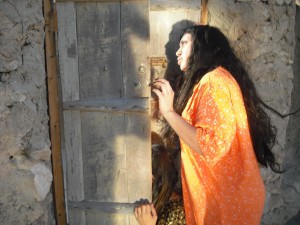
Sex talk: opening the door to freedom.
After gaining huge popularity, she shifted to more daring topics, such as sex during menstruation (a taboo among Muslims), passionate kissing and the anatomically correct description of genital parts.
In each show Dr Duree boldly discusses bold sex-related topic and receives calls from viewers calling for help in their sex-related conflicts. Although those programmes are opposed by hardliners, they are gaining popularity day by day.
Love Tales can be seen in Saudi Arabia. Let’s spare a compassionate thought for the poor cameraman jailed for something he could do freely in other Arab countries.
Images from the movie Anklet Dancer, Bharain 2008. Courtesy of director Ali Al ALi.
]]>http://www.campaignforrealbeauty.ca/bblank.asp?id=6895
Digital cosmetic surgery – nip-and-tuck, botox and liposuction, on the screen, with a click – render these models picture-perfect (excuse the pun) and thoroughly unreal.
There [...]]]>
http://www.campaignforrealbeauty.ca/bblank.asp?id=6895
Digital cosmetic surgery – nip-and-tuck, botox and liposuction, on the screen, with a click – render these models picture-perfect (excuse the pun) and thoroughly unreal.
There is no way a non-photoshopped woman can attain that perfection. Hey, we are human. We have flaws.
In France and the UK, women lawmakers recently proposed that ads should disclose when their photos have been digitally manipulated to a great extent. They argue that bodily digital perfection in ads undermines the body image and self-esteem of girls and women.
Anorexia, bulimia, eating disorders, obsession with thinness and unnecessary cosmetic surgery follow. Meanwhile, sales of weight-loss products and push-up bras soar.
The tricky problem for lawmakers and advertisers alike is where to draw the line between (acceptable) touching up a pimple or a wrinkle and engaging in full (unacceptable) deception.
Among the most egregious offenders: the French magazine Paris Match nipped the bulging love handles of President Nicholas Sarkozy, in evidence while he canoed bare-chested in the USA.
Oprah Winfrey always has a waist in the cover of O magazine, while flat-chested Keira Knightley miraculously acquired big boobs for her recent Chanel Mademoiselle perfume ad.
The alcoholic drink Campari must have some magical effects on bones because actress Jessica Alba got sharper collarbone and knee definition, longer arms and a tinier waist in its recent ad.
Eating disorders once afflicted mostly affluent white teen girls in the West. Now they have spread across the world, among all ages and ethnic groups and, increasingly, among young men.
It is harder to quantify how the unreal perfect bodies in ads distort the self-image of girls and boys worldwide.
Watch the video and share your thoughts about the proposed disclosure measures.
]]>Burqa-wearing women may lose the right to drive in Bahrain over a conflict between government and conservative lawmakers.
The government wants to amend the traffic law and grant male traffic officers the right to ask women to lift the veil and show their faces.
On the other [...]]]>
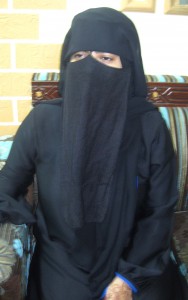
Dressed to drive? By S.Hamada
Burqa-wearing women may lose the right to drive in Bahrain over a conflict between government and conservative lawmakers.
The government wants to amend the traffic law and grant male traffic officers the right to ask women to lift the veil and show their faces.
On the other hand, some lawmakers are loath to approve the amendment or at least demand that female traffic officers be employed for this task.
Let’s hope that in either way it will be a win-win situation for women: that they will continue to drive, and enter a job sector that has been reserved for men since the 1970s. Bahrain doesn’t impose a dress code on women. Wearing a burqa (or Niqab, in Bahrain) is a personal choice.
OK, not all women here wear a burqa as personal choice; some do it to obey their male relatives or conservative families. Whatever the reasons, burqa limits women’s social and professional activities. For example, they cannot eat at restaurants without closed cabins nor work in many sectors except those with limited, female-only jobs.
Anyway, women who feel comfortable wearing a burqa shouldn’t be discriminated or underestimated. Females worldwide should be allowed to speak their minds, lead their lives to the fullest and freely practice their faiths.
Forcing women to take off their burqa is as cruel as forcing the veil on them.
A measure of independence
Burqa-wearing women in Bahrain have one important right – they can drive.
This is fairly new. Before 2006, burqa-wearing women drivers were harassed by traffic officers and fined.
In 2006 the government allowed burqa-clad drivers as a result of pressure from conservative MPs, who represent the majority of the Lower House, with the proviso that these women should, if requested, show their faces to traffic officers, for security reasons.
Not all were pleased with that decision. A Bahraini columnist, Abdullah Al Ayobi, argues that, for security reasons, fully covered women should not drive. He wrote last year that Bahrain was the only country in the world that allows unidentified individuals to drive.
Being able to drive has made life easier for women, especially with Bahrain’s poor public transportation.
We will soon know whether burqa-wearing women will continue to drive legally in Bahrain.
]]>Seven PM at the supermarket. After a long day at the office, she is standing in line to pay for groceries to make dinner, stealing glances at her watch, grappling with two young kids who want her to buy some chewing gum…
Does this picture ring a bell? Survey [...]]]>
Seven PM at the supermarket. After a long day at the office, she is standing in line to pay for groceries to make dinner, stealing glances at her watch, grappling with two young kids who want her to buy some chewing gum…

Unequal sharing of the work pie. M. Sayagues
Does this picture ring a bell? Survey after survey across the world report that women put in between 20 and 30 hours a week of domestic and family work. Unseen, unsung and unpaid, yes, but not insignificant.
Unpaid work in the home, done mainly by women, is estimated at approximately 50 percent of all productive activity even in industrial countries, and as much as 60-70 percent in many developing countries,” says Hazel Henderson in an interview with IPS.
“The U.N. Human Development Report and its Human Development Index (HDI) in 1996 calculated that unpaid work was estimated at 16 trillion dollars (11 trillion dollars by women and 5 trillion dollars by men). This figure was simply missing from the official global GDP figure of 24 trillion dollars, although a truer figure would have been 40 trillion dollars for global GDP in 1996.”
Henderson – futurist, economic iconoclast, founder of Ethical Markets Media and author - was commenting on the just published “Stiglitz-Sen Report”, which argues that countries need to find ways to measure well-being alongside raw economic growth.
Having dedicated her studies to an interdisciplinary economic and political theory focused on environmental and social issues, her views couldn’t be more pertinent.
(Find Henderson’s books)
]]>Have you seen the Italian documentary Il corpo delle donne (available with English subtitles)?
It is horrifying, like a horror movie.
“Women –real women— are an endangered species on television, one that is being replaced by a grotesque, vulgar and humiliating representation,” says an introduction to the documentary [...]]]>
Have you seen the Italian documentary Il corpo delle donne (available with English subtitles)?
It is horrifying, like a horror movie.
“Women –real women— are an endangered species on television, one that is being replaced by a grotesque, vulgar and humiliating representation,” says an introduction to the documentary by Lorella Zanardo.
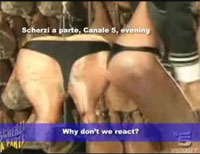
This picture shows a woman hanged from the ceiling, like a ham, surrounded by legs of ham. This and other images, taken from real TV shows, speak for themselves.
Il corpo delle donne is a 25-minute terrifying documentary that undresses the degradation of women in Italian television.
“This led us to select television images that share a common manipulative exploitation of the woman’s body, to let people know what is happening –not only people who never watch television, but especially those who watch it but ‘don’t see’,” says the introduction.
Why aren’t women, and men, rallying against this treatment?
Link with Il Corpo delle Donne in Facebook.
]]>Some of those championing Caster Semenya’s cause accuse those wanting to sex-test Caster of imperialism and racism (as well as sexism). Others plead to wait before reaching a verdict, arguing that the realities of sex testing are enormously complex
Firstly to address the issue of terminology, over which [...]]]>
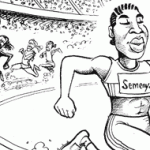
Courtesy of Zapiro, Mail & Guardian
Some of those championing Caster Semenya’s cause accuse those wanting to sex-test Caster of imperialism and racism (as well as sexism). Others plead to wait before reaching a verdict, arguing that the realities of sex testing are enormously complex
Firstly to address the issue of terminology, over which there seems to be confusion. Gender is the dominant society’s views on how women and men should look, behave, what roles they should play in society, how they should perform and frequently what rewards they receive – hence gender inequity. This has usually led to lower status and discrimination against girls/women but has increasingly been seen as limiting the options and potentially harming boys/men too.
Gender is not a politically correct term for sex. Sex testing would be just that – establishing whether a person is biologically female or male. So gender testing is not the term that should be used this case, but sex testing.
Secondly, to tackle the science issue, as this tends to obscure the real issue of gender stereotyping and discrimination so evident in this case. Professor Tim Noakes, an international sports science expert says the issue of ‘unfair advantage’ which is the only thing that should be at play here as it is in the case of drug use,is simple to establish.
He states that the issue that needs to be clarified here is whether the person concerned is a man masquerading as a woman or not. This could be established by a simple physical examination “handled within the usual constraints of the doctor/patient domain – not in the public domain” as has happened in the harmful manner in which the IAAF has handled this.
As for the rest, he says, there is great variation. All other possible tests including chromosome testing is indeterminate and so that should be left well alone. The calls for more to be done in dealing with
this issue and await judgment are therefore erroneous and cloud the issue in a shroud of inappropriate so-called scientific enquiry.
Sissies and butch
The third issue relates to what lies at the heart of the matter, social norms. While issues of racism and imperialism have and will continue to apply in various circumstances and have a sensitive history in terms of
women’s bodies, particularly in Africa, focusing on these issues in the current context obscures the much neglected ‘elephant in the room’ - gender discrimination. Comments within the press and on talk shows are
unwittingly guilty of this same problem in placing ‘blame’ at Athletics South Africa or her coach’s door.
They argue that the authorities should have pre-empted this situation, given her prior experiences (at the hands of the teachers, members of the public and previous authorities). ‘Pre-empting the situation’ would fall prey to the exactly these same prejudices – pandering to what people perceive to be ‘normal’ for girls or women.
This is akin to what might have happened during the apartheid era where actions may have tried to stave off racism by negotiating black people’s entry into racially reserved sporting or cultural events before the
time.
Many white girls who do not ‘look’ as society expects will tell similar humiliating stories of being stopped from entering female public toilets or being questioned as to whether they male or female.
At the core of this issue are ideas about gender – how girls/women and boys/men look and behave and perform (in this case perhaps a young woman winning by 2 seconds ahead of the field is not seen as ‘normal’).
This is what has been so hard to address locally in South Africa, despite our progressive constitution, due to deeply held dominant ideas about what is ‘female’ and ‘male’. It is these ideas and actions that promote gender discrimination. This leads to men, who in societies’ terms do not look ‘masculine enough’, being called ‘sissies’ and women who look not ‘feminine enough’ being labelled ‘butch’.
At the root, gender discrimination
In our own society, this has led to violent attacks on some women and in our own and other countries to violent attacks on some boys/men. This is what we need to clearly point as underlying this case and name it for what it is. Framing the discrimination as racism or imperialism without reference to gender discrimination as the main issue risks reinforcing gender stereotypes.
Societies have a long way to go in terms of changing the dominant ideas on how women and men should look and behave and perform, and in some cases, dress – and allow for variations in ‘looks’ and roles to be
underpinned by what people would like to be and do, rather than societies’ current dominant expectations.
There are many excellent organisations in our own country and abroad that have worked with women and men on this issues, but as it is all to obvious from this and other cases, much work is still needed for these choices and this freedom to take root in the broader society as a whole.

Supporters at the airport. Photo: Marion Stevens
Caster should not be having to deal with a world controversy over her win. She should be unreservedly basking in the glory of her and our incredible victory. No doubt she has experienced this humiliation and discrimination at other levels before and has become somewhat hardened to its effect, but we wish her, her friends and her family strength in dealing with this blatant gender discrimination.
As Caster Semenya and our other gold medal winner, Mbulaeni Mulaudzi, return home – congratulations on your amazing wins and Caster, you have our ful lsupport. For the rest, to Caster’s detractors or apologists, hang your heads in shame for not ‘naming’ the issue for what it is and for perpetuating gender stereotypes and discrimination in her individual case and in society as a whole.’
As we once again approach the 16 days of activism against violence against women, let us bear these issues in mind and not mouth platitudes in our struggle against gender inequity and discrimination.
Diane Cooper – Director, Women’s Health Research Unit, School of Public
Health and Family Medicine, University of Cape Town
Leslie London, Director, School of Public Health and Family Medicine,
University of Cape Town
Nomfundo Eland , Treatment Action Campaign (TAC) Women’s Rights Campaign
Larissa Klazinga and Rhodes Gender Action Project
Lisa Vetten, Tshwaranang Legal Advocacy Centre to End Violence Against Women
Nomfundo Eland, TAC Women’s Rights Campaign
Shirley Walters, University of Western Cape, South Africa
Lillian Artz, Director, Gender, Health and Justice Unit, University of Cape Town, South Africa
Glenn de Swardt, Health4Men
Jane Harries, Associate Director, Women’s Health Research Unit,
University of Cape Town
Jennifer Moodley, Women’s Health Research Unit, University of Cape Town
Sheila Meintjes, Political Studies Department, Wits University
Ilse Ahrends, the Saartjie Baartman Centre for Women and Children
Phumi Mtetwa,the Lesbian and Gay Equality Project
Marion Stevens, Health Systems Trust
Sipho Mthathi, Human Rights Watch South Africa.
Deborah Byrne, Foundation for Human Rights (FHR)
Sumaya Mall, Women’s Health Research Unit, University of Cape Town
Ntobeko Nywagi, Women’s Health Research Unit, University of Cape Town
Sheila Cishe, Women’s Health Research Unit, University of Cape Town
Chelsea Morroni, Women’s Health Research Unit, University of Cape Town
Phyllis Orner, Women’s Health Research Unit, University of Cape Town
Regina Mlobeli, Women’s Health Research Unit, University of Cape Town
Mary Jansen (KIWIA) Khoe San Indigenous Women in Action
Angelica Pino, Gender-based Violence Programme, Centre for the Study of
Violence and Reconciliation
Shireen Hassim, University of Witwatersrand, South Africa
Linda Cooper, Centre for Higher Education and Development, University
of Cape Town
Akosua Adomako Ampofo, Inst. of African Studies and Head, Centre for
Gender Studies & Advocacy, University of Ghana, Legon
Cathy Mathews, Medical Research Council
Fareeda Jadwat, African Gender Institute, University of Cape Town
Ilse Ahrends,Saartjie Baartman Centre for Women and Children, South
Africa
Di McIntyre, NRF chair, Health Economics Unit, University of Cape Town
Andrea Rother, Centre for Occupational and Environmental Health
Research, University of Cape Town
Carol Thomas, thewomanspace
Johanna Kehler, Director, AIDS Legal Network, South Africa
Carrie Shelver, People Opposing Women Abuse, South Africa
Gabi Jiyane, the Lesbian and Gay Equality Project
Balise Mahlangu, the Lesbian and Gay Equality Project
Ayanda Rapita, the Lesbian and Gay Equality Project
Gertrude Fester, Feminist Forum/ Women’s and Gender Studies,University
of Western Cape
Naeemah Abrahams, Gender and Health Research Unit, Medical Research
Council, South Africa
Angelica Pino, Gender-based Violence Programme, Centre for the Study of
Violence and Reconciliation, South Africa
Pamela Scully, Women’s Studies and African Studies, Emory University &
Deputy Editor, Women’s History Review
Mary Jansen (KIWIA) Khoe San Indigenous Women in Action
Melissa Steyn, Department of Sociology, University of Cape Town, South
Africa
Gabi Jiyane,the Lesbian and Gay Equality Project
Marion Heap, Health and Human Rights, School of Public Health and
Family Medicine,University of Cape Town
Balise Mahlanguthe, Lesbian and Gay Equality Project
Bernadette Bredekamp, Division of Family Medicine, University of Cape
Town
Ayanda Rapita, the Lesbian and Gay Equality Project
Larissa Klazinga and Rhodes Gender Action Project
Laura Pollecutt, South Africa
Sokari Ekine,London
Natasha Primo
Alex Kent
Annemarie Hendrikz
Jon Weinberg, Cape Town
Eva Hunt, South Africa
Shirley Gunn, Cape Town
Susan Holland-Muter, South Africa
Tara Weinberg, Cape Town Lavona George, South Africa
Gille de vlieg, South Africa
Michael Weinberg, Cape Town
Anne Schuster, South Africa
Jenny Radloff, South Africa
Kathy Watters, Cape Town
Sakina Mohamed, South Africa
Nicolene McLean, Gender Action Project
Carla Tsampiras, Rhodes History Dept
Corinne Knowles, GENACT
Alan Kirkaldy, NTESU
Thava Govender, Human Development Consulting Agency,KZN, South Africa
Richard Matzopoulos, Medical Research Council and UCT Public Health
Bernedette Muthien, Engender
Sally Gross,Intersex South Africa
Surplus People Project, South Africa
Sharon Stanton, S.L Stanton Attorneys
Tessa Lewin, Communications Manager, Pathways of Women’s Empowerment,
Institute of Development Studies, UK
Nisaa Institute for Women’s Development